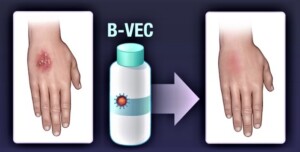Written by Emil Luca: Beremagene geperpavec, or B-VEC, is the world’s first topical gene therapy that showed promising results in patients suffering from dystrophic epidermolysis bullosa, a rare genetic blistering skin disease.
Dystrophic Epidermolysis Bullosa (DEB)
DEB is a rare and severe disease that affects the skin and mucosal tissues. It is caused by one or more mutations in a gene called COL7A1, which is responsible for the production of the protein type VII collagen (COL7) that forms anchoring fibrils that bind the dermis (inner layer of the skin) to the epidermis (outer layer of the skin). The lack of functional anchoring fibrils in DEB patients leads to extremely fragile skin that blisters and tears from minor friction or trauma. DEB patients suffer from open wounds, which leads to skin infections, fibrosis which can cause fusion of fingers and toes, and ultimately an increased risk of developing an aggressive form of squamous cell carcinoma which, in severe cases, can be fatal.
The topical gene therapy B-VEC
B-VEC is a herpes simplex virus type 1 (HSV-1)-based investigational non-invasive topical gene therapy designed to deliver two copies of the COL7A1 gene when applied directly to DEB wounds. B-VEC was designed to treat DEB at the molecular level by providing the patient’s skin cells with the template to make normal COL7 protein, thereby addressing the fundamental disease-causing mechanism.
B-VEC is provided by Krystal Biotech, Inc., a biotechnology company focused on developing and commercializing genetic medicines for patients with rare diseases. The US Food and Drug Administration (FDA) and the European Medical Agency (EMA) have each granted B-VEC orphan drug designation for the treatment of DEB.
Phase 3 trial of the topical gene therapy
Results of phase 3 trial of the topical gene therapy were published in the New England Journal of Medicine: Guide S.V. et al. Trial of Beremagene Geperpavec (B-VEC) for Dystrophic Epidermolysis Bullosa. N Engl J Med 2022; 387:2211-2219. DOI: 10.1056/NEJMoa2206663.
Phase 3, double-blind, intrapatient randomized, placebo-controlled trial involved patients 6 months of age or older with genetically confirmed DEB. For each patient, a primary wound pair was selected, with the wounds matched according to size, region, and appearance. The wounds within each pair were randomly assigned in a 1:1 ratio to receive weekly application of either B-VEC or placebo for 26 weeks.
Complete wound healing at 3 and 6 months in patients with dystrophic epidermolysis bullosa was more likely with topical administration of B-VEC than with placebo. Pruritus and mild systemic side effects were observed in patients treated with B-VEC. Longer and larger trials are warranted to determine the durability and side effects of B-VEC for this disease.
Sources:
New England Journal of Medicine.
The writer declares no conflict of interest.
See also:
Thalassemia Gene Therapy Approved by FDA

More information from Stanford Medicine:
Gene therapy gel heals decades-old wounds in trial for blistering skin disease.
https://med.stanford.edu/news/all-news/2022/12/epidermolysis-bullosa-gel.html
The whole story is told nicely here:
World-first topical gene therapy gel heals decades-old wounds
https://newatlas.com/health-wellbeing/topical-gene-therapy-gel-heals-wounds-phase3-trial/